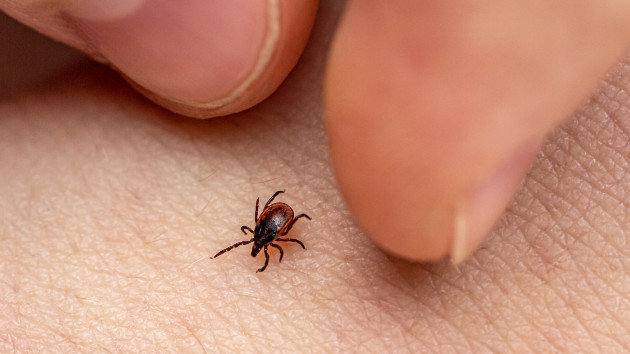(NEW YORK) — Researchers are one step closer to developing a vaccine for Lyme disease, which affects nearly half a million people each year in the United States, according to the U.S. Centers for Disease Control and Prevention.
Pfizer, the maker of a COVID-19 vaccine, announced Monday it is starting a phase 3 clinical trial on its Lyme disease vaccine, known as VLA15.
The study will include over 6,000 participants from 50 locations around the world, including the U.S. Children ages 5 and older will also be included in the study, according to Pfizer.
“With increasing global rates of Lyme disease, providing a new option for people to help protect themselves from the disease is more important than ever,” Annaliesa Anderson, Ph.D., senior vice president and head of vaccine research and development at Pfizer, said in a press release announcing the study. “We hope that the data generated from the Phase 3 study will further support the positive evidence for VLA15 to date, and we are looking forward to collaborating with the research sites across the U.S. and Europe on this important trial.”
Lyme disease, the most common vector-borne disease in the U.S., is a tick-borne infectious disease that, if left untreated, can affect the joints, heart and nervous system, according to the CDC.
There has not been a vaccine for the disease for the past 20 years. The most recent vaccine for the disease, LYMErix, was discontinued in the U.S. in 2002.
“This one is protein-based vaccine technology,” ABC News chief medical correspondent Dr. Jennifer Ashton said of the new Pfizer vaccine. “It’s important to prevent not only short-term signs and symptoms of Lyme disease but long term, so we’re talking about things like short-term fever, headache, fatigue, rash, and then if untreated, it can spread to the joints, heart and central nervous system.”
The vaccine is administered through three shots given over a period of several months, followed by a booster dose 12 months later, according to Pfizer, who is developing the vaccine with Valneva, a French biotech firm.
If the trial moves forward as planned, Pfizer said it expects to submit an authorization request to the U.S. Food and Drug Administration in 2025.
Lyme disease, mainly caused by the bacterium Borrelia burgdorferi, is transmitted to humans via tick bites. In most cases, the tick must be attached to the skin for at least 36 hours before the bacterium can be transmitted.
Symptoms generally appear after one week, with approximately 70% to 80% of people experiencing a classic “bull’s eye” rash which expands in size at the site of the bite.
Symptoms in the acute phase include fever, headache and fatigue. If left untreated, the infection can spread to joints, the heart and the nervous system. People also may experience lingering symptoms that last months or even years, such as muscle and joint pain, cognitive defects and sleep disturbances, according to the CDC.
Once confirmed with laboratory testing, most cases can be treated for a few weeks with antibiotics. According to the Mayo Clinic, Lyme disease should be treated immediately and may require intravenous antibiotics if the case is severe.
Lyme disease is most commonly found in the Northeast and upper Midwest, with 96% of all cases in 14 states — Connecticut, Delaware, Maine, Maryland, Massachusetts, Minnesota, New Hampshire, New Jersey, New York, Pennsylvania, Rhode Island, Vermont, Virginia and Wisconsin, according to the CDC.
The CDC recommends preventive measures to avoid ticks including avoiding “wooded and brushy areas with high grass and leaf litter” and walking in the center of trails.
When hiking or in wooded areas, you can also treat your clothes and gear with products containing 0.5% permethrin, according to the CDC. They also recommend always doing a “tick check” after being outside and wearing insect repellent with Deet.
Ticks can also come into the home through clothing and pets, so the CDC recommends checking pets for ticks and tumble drying clothes on high heat for 10 minutes after coming indoors to kill ticks.
If you are ever in a situation where you are bitten by a tick, the Cleveland Clinic recommends tugging gently but firmly near the head of the tick until it releases its hold on the skin.
People who are outdoors in areas that may have ticks should also conduct a full body check when they return, including checking under the arms, in and around the ears, inside the belly button, behind the knees, in and around the hair, between the legs and around the waist, the CDC recommends.
Copyright © 2022, ABC Audio. All rights reserved.












